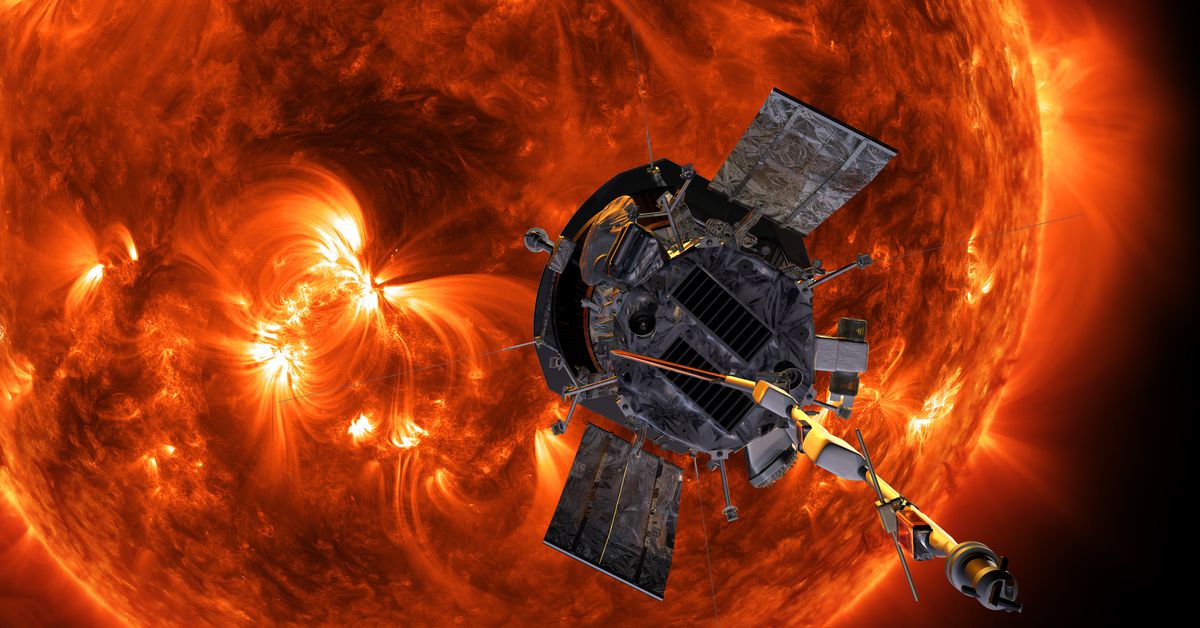The Parker Solar Probe (PSP) launched its mission toward the Sun on December 20, 2018, with the goal of studying the Sun’s corona—the Sun’s outermost layer—and its extreme heat. The probe was designed to achieve unprecedented proximity to the Sun, reaching as close as 3.8 million miles (6.1 million kilometers) from its surface during its closest approach on December 24, 2023. This remarkable feat of engineering and science has now been confirmed by signals transmitted back to Earth, showcasing the probe’s resilience and scientific capabilities.
Close Approach to the Sun
The Parker Solar Probe operates at an unprecedented speed of approximately 430,000 miles per hour (690,000 kilometers per hour) during its closest encounter with the Sun. This high-speed trajectory ensures that it remains well within Earth’s orbit while transmitting data directly back to NASA’s ground stations. The probe’s instruments are designed to withstand the extreme conditions of such a proximity, including intense solar radiation and the intense heat generated by the Sun’s surface.
During its journey toward the Sun, the probe encountered an extended period of communicationlessness, spanning from December 21 to December 24, 2023. This was due to the Sun’s intense radiation field, which caused the probe’s instruments to lose signal contact with NASA’s Deep Space Network (DSN). However, on December 26, 2023, just three days after closest approach, the probe successfully transmitted a signal back to Earth. According to NASA officials, this transmission confirmed that the probe was operating normally and in good health.
Mission Success and Data Transmission
The successful transmission of data by the Parker Solar Probe on December 26 marked a significant milestone in the mission’s history. The probe is expected to send detailed telemetry data about its status throughout the remainder of its journey, beginning with a signal scheduled for January 1, 2024. This data will provide valuable insights into the Sun’s magnetic fields, solar wind dynamics, and other critical aspects of solar activity.
The Parker Solar Probe’s trajectory toward the Sun was carefully calculated to ensure that it would pass within 3.8 million miles (6.1 million kilometers) of the Sun’s surface on December 24, 2023. This close encounter is intended as a test of the probe’s ability to survive in such extreme conditions. The mission is designed not only to study the Sun’s corona but also to provide critical data for understanding solar wind generation and the acceleration of high-energy particles to speeds nearing light speed.
The Probe’s Design and Capabilities
The Parker Solar Probe is equipped with a range of advanced scientific instruments, including magnetometers, spectrometers, and heat imagers. These instruments will allow researchers to study the Sun’s atmosphere, magnetic fields, and the behavior of charged particles near the Sun’s surface. The probe also features a high-temperature heat shield capable ofwithstanding temperatures exceeding 2,500 degrees Fahrenheit (1,370 degrees Celsius), while the rest of the probe maintains an internal temperature of just 85 degrees Fahrenheit (-46 degrees Celsius). This design ensures that the probe can survive in the intense radiation and heat generated by the Sun’s surface.
The probe’s ability to function so close to the Sun is a testament to its advanced engineering and design. The spacecraft was built with modular components, allowing for flexibility in scientific objectives as it navigates through different phases of its mission. The success of this mission highlights the potential for future space-based probes to explore other celestial bodies while conducting groundbreaking research.
Mission Significance
The Parker Solar Probe’s journey toward the Sun represents a major milestone in humanity’s quest to understand our solar system. By studying the Sun’s corona and the surrounding plasma, scientists hope to gain insights into the mechanisms that drive solar activity, including solar flares, coronal mass ejections, and their effects on Earth’s space environment. These phenomena can have significant impacts on satellite operations, power grids, and even weather patterns here on Earth.
The probe’s data will also contribute to our understanding of how high-energy particles are accelerated to speeds close to the speed of light—a process that is still not fully understood by scientists. By studying these high-energy particles, researchers hope to shed light on the fundamental physics that governs their behavior and acceleration.
Conclusion
In conclusion, NASA’s Parker Solar Probe mission represents a remarkable achievement in space exploration and scientific discovery. Its successful transmission of data from an unprecedented proximity to the Sun validates its design and operational capabilities while providing valuable insights into some of the most extreme conditions in our solar system. The probe’s journey toward the Sun will continue to yield critical data for understanding the Sun, its corona, and the surrounding plasma, paving the way for future space-based probes and missions that aim to explore other celestial bodies.
As the Parker Solar Probe continues its journey through the solar system, it stands as a testament to human ingenuity and our enduring quest to explore and understand the universe. The data it collects will undoubtedly shape our understanding of the Sun and its role in our solar system for years to come.
